Report on Asosan (Japan) — July 1992
Bulletin of the Global Volcanism Network, vol. 17, no. 7 (July 1992)
Managing Editor: Lindsay McClelland.
Asosan (Japan) Phreatic activity and seismicity decline after block ejection
Please cite this report as:
Global Volcanism Program, 1992. Report on Asosan (Japan) (McClelland, L., ed.). Bulletin of the Global Volcanism Network, 17:7. Smithsonian Institution. https://doi.org/10.5479/si.GVP.BGVN199207-282110
Asosan
Japan
32.8849°N, 131.085°E; summit elev. 1592 m
All times are local (unless otherwise noted)
Blocks were ejected during the night of 30 June-1 July from Crater 1 for the first time since . . . December 1990. Vigorous steam emission followed for about 10 days, fed a plume to a maximum of 2 km height on 6 and 8 July, then gradually declined toward the end of the month (figure 19). Ejections of water, mud, and blocks that rose ~50 m above the surface of the crater lake were observed almost every day during July. The lake shrank rapidly in early July until it occupied only about 1/3 of the crater floor. The temperature of the lake surface (measured by infrared thermometer) reached 95°C on 4 July (figure 19), the highest since March 1991, but declined to around 60° by the end of the month. Isolated tremor episodes, which had peaked at ~2,000/day at the end of June, declined rapidly after the block ejection to 0-6/day (figure 19). The amplitude of post-eruption continuous tremor also declined (figure 20).
 |
Figure 20. Daily mean amplitude of continuous tremor at Aso, late 1988-July 1992. Long arrows mark strong explosions, short arrows indicate weak ash emissions. Courtesy of JMA. |
Similar activity continued through mid-August, with weak mud ejections from the lake, steady steam emissions to 1,000 m height, and low-level seismicity. The lake expanded again to cover all of the crater floor by 5 August because of inflow of groundwater, precipitation, and weaker ejection activity.
The area within 1 km of the crater . . . was reopened on 10 August.
Geological Summary. The 24-km-wide Asosan caldera was formed during four major explosive eruptions from 300,000 to 90,000 years ago. These produced voluminous pyroclastic flows that covered much of Kyushu. The last of these, the Aso-4 eruption, produced more than 600 km3 of airfall tephra and pyroclastic-flow deposits. A group of 17 central cones was constructed in the middle of the caldera, one of which, Nakadake, is one of Japan's most active volcanoes. It was the location of Japan's first documented historical eruption in 553 CE. The Nakadake complex has remained active throughout the Holocene. Several other cones have been active during the Holocene, including the Kometsuka scoria cone as recently as about 210 CE. Historical eruptions have largely consisted of basaltic to basaltic-andesite ash emission with periodic strombolian and phreatomagmatic activity. The summit crater of Nakadake is accessible by toll road and cable car, and is one of Kyushu's most popular tourist destinations.
Information Contacts: JMA.


